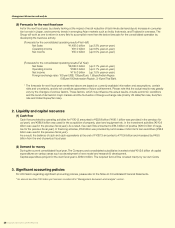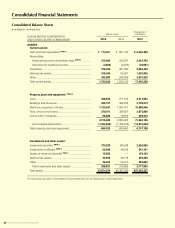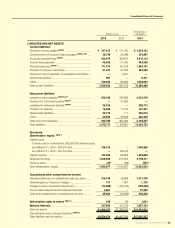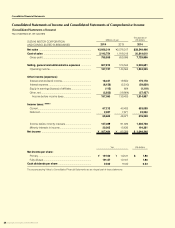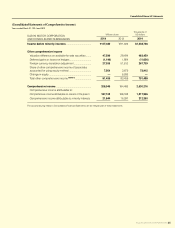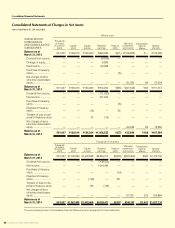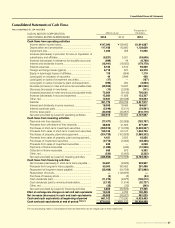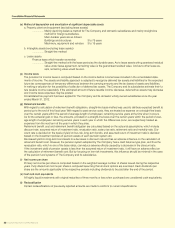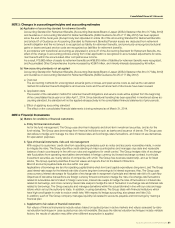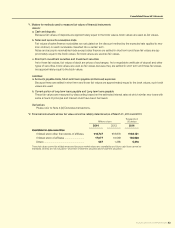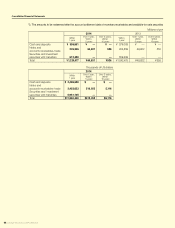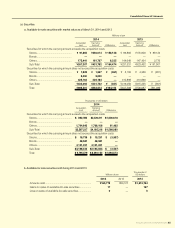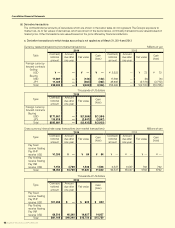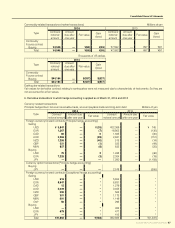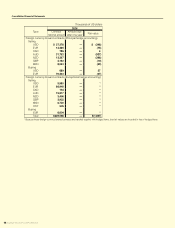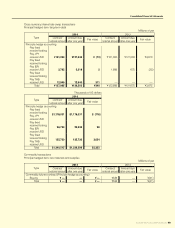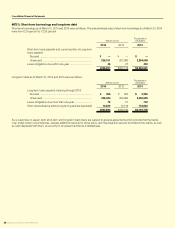Suzuki 2014 Annual Report Download - page 42
Download and view the complete annual report
Please find page 42 of the 2014 Suzuki annual report below. You can navigate through the pages in the report by either clicking on the pages listed below, or by using the keyword search tool below to find specific information within the annual report.
40 SUZUKI MOTOR CORPORATION
Consolidated Financial Statements
(o) Methodofdepreciationandamortizationofsignicantdepreciableassets
a. Property, plant and equipment (excluding lease assets)
................. Mainly declining balance method for The Company and domestic subsidiaries and mainly straight-line
method for foreign subsidiaries.
Main durable years are as follows:
Buildings and structures 3 to 75 years
Machinery, equipment and vehicles 3 to 15 years
b. Intangible assets (excluding lease assets)
................. Straight-line method
c. Lease assets
Finance lease which transfer ownership
................. Straight-line method with the lease period as the durable years. As to lease assets with guaranteed residual
value under lease agreement, remaining value is the guaranteed residual value. And as to other lease as-
sets, remaining value would be zero.
(p) Income taxes
The provision for income taxes is computed based on the income before income taxes included in the consolidated state-
ments of income. The assets and liability approach is adopted to recognize deferred tax assets and liabilities for the expected
future tax consequences of temporary differences between the carrying amounts and the tax bases of assets and liabilities.
In making a valuation for the possibility of collection of deferred tax assets, The Company and its subsidiaries estimate their fu-
ture taxable income reasonably. If the estimated amount of future taxable income decrease, deferred tax assets may decrease
and income taxes expenses may be posted.
Consolidated tax payment has been applied to The Company and its domestic wholly owned subsidiaries since the year
ended March 31, 2012.
(q) Retirementbenets
With regard to calculation of retirement benet obligations, straight-line basis method was used to attribute expected benet to
period up to the end of this scal year. With regard to past service costs, they are treated as expense on a straight-line basis
over the certain years within the period of average length of employees’ remaining service years at the time when it occurs.
As for the actuarial gain or loss, the amounts, prorated on a straight-line basis over the certain years within the period of aver-
age length of employees’ remaining service years in each year in which the differences occur, are respectively treated as
expenses from the next term of the year in which they arise.
Retirement benet cost and retirement benet obligation are calculated based on the actuarial assumptions, which include
discount rate, assumed return of investment ratio, revaluation ratio, salary rise ratio, retirement ratio and mortality ratio. Dis-
count rate is decided on the basis of yield on low-risk, long-term bonds, and assumed return of investment ratio is decided
based on the investment policies of pension assets of each pension system etc.
Decreased yield on long-term bond leads to a decrease in discount rate and has an adverse inuence on the calculation of
retirement benet cost. However, the pension system adopted by The Company has a cash balance type plan, and thus the
revaluation ratio, which is one of the base ratios, can reduce adverse effects caused by a decrease in the discount rate.
If the investment yield of pension assets is less than the assumed return of investment ratio, it will have an adverse effect on
the calculation of retirement benet cost. But by focusing on low-risk investments, this inuence should be minimal in the case
of the pension fund systems of The Company and its subsidiaries.
(r) Net income per share
Primary net income per share is computed based on the weighted average number of shares issued during the respective
years. Fully diluted net income per share is computed assuming that all stock options are exercised. Cash dividends per
share are the amounts applicable to the respective periods including dividends to be paid after the end of the period.
(s) Cash and cash equivalents
All highly liquid investments with original maturities of three months or less when purchased are considered cash equivalents.
(t) Reclassication
Certain reclassications of previously reported amounts are made to conform to current classications.


